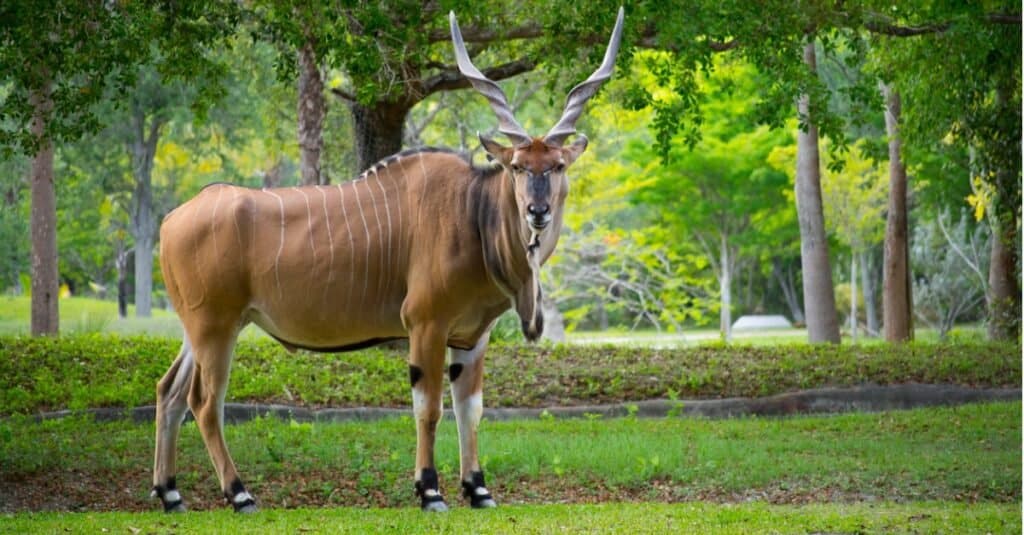While both are hoofed mammals belonging to the Bovid family, do you know that there are distinct differences between antelopes and gazelles? It may interest you to know that all gazelles are antelopes, but not all antelopes are gazelles. There are 91 species of antelope, 13 of which are members of the genus Gazella, better known as gazelles. Both animals are natives of Africa and Asia. However, 72 species of antelopes can be found mainly in the deserts, wetlands, savannas, grasslands, open plains, and forests of Africa.
So, what are the differences between an antelope and a gazelle? This article will unravel all you need to know about both animals, including their diets, size, behavior, horns, and preferred habitats. We will also give a detailed description of their physical appearance as well as their overall lifespan.
Comparing Antelopes vs Gazelles

| Antelopes | Gazelles | |
|---|---|---|
| Physical Appearance | Brown-colored with white or pale bellies and a dark lateral stripe. Also, in most other antelope species, only males have horns. | Most gazelles are fawn-colored with white underparts or rump patches and a dark stripe along the body. Both males and females develop horns. |
| Size | They can reach up to 6 feet in height and over 2000 pounds. | Gazelles grow to the height of 2 to 3.5 feet in length and weigh about 66 pounds. |
| Geographical Location | Wetlands, grasslands, mountains, and open plains. | Desert. |
| Stotting | The antelopes do not stot. | Gazelle stotting involves an impressive leap, with all four hooves leaving the ground to escape predators. |
| Speed | Quick runners, some of them can reach up to 43 miles per hour. | They are considered swift animals and can run for about 60 miles per hour at a sustained speed. |
| Behavior | They live in large groups called herds | They are very social animals and live in herds from a few up to 700 animals. |
| Lifespan | They can live for around 10 years in the wild. | They have a lifespan of about 12 – 15 years in the wild. |
The Key Differences Between Antelopes and Gazelles
The key differences between antelopes and gazelles are appearance, stotting, habitat, speed, and lifespan.
Antelopes are a miscellaneous group of animals of the order Artiodactyla. All antelopes have even-toed hooves, horizontal pupils, and well-developed teeth for grinding. They are known as ruminants with bony horns. Twenty-five species of them are endangered and are faced with extinction due to the continuous loss of habitats.
Like antelopes, gazelles are herbivores, and they spend most of their time eating. They have little or no need for water, as they tend to extract moisture from the shoots, grass, and leaves that they eat. Moreover, most existing gazelles are considered threatening to varying degrees.
Let’s look further and examine even more differences between these animals.
Antelope vs Gazelle: Physical Appearance

Antelopes are usually brown-colored on the dorsal side and white-colored on the central side of their bodies.
©Petr Ganaj/Shutterstock.com
Antelopes are usually brown-colored on the dorsal side and white-colored on the central side of their bodies. Many are covered with variants of grey, black, and white stripes, while others have a black or grey body and a white face. On the other hand, most gazelles are light, fawn-colored with white underparts or rump patches and a dark stripe with contrasting facial markings.
Antelope vs Gazelle: Size
Generally, gazelles are relatively small antelopes. They grow to a height of 2 to 3.5 feet at shoulder length and weigh around 66 pounds. One popular gazelle is the Thompson gazelle, which is about 24 to 28 inches in height. Unlike gazelles, antelopes measure about 6 feet at shoulder length and can weigh over 2000 pounds. The largest antelope is the eland, with a length of 6 feet and weighing about 2200 pounds, while the smallest is the royal antelope, with a height of about 10 to 12 inches.
Antelope vs Gazelle: Horns

Gazelles have horns that curve backward, are broad at the base, and are sharply pointed.
©iStock.com/StuPorts
One easy way to differentiate between these two animals is to look at their horns. All antelope horns are hollow. However, in most species, only males develop them. They are permanent and may be straight, ridged, curved, or twisted, depending on the species. Unlike deer antlers, antelopes don’t replace their horns annually. They grow continuously throughout their lives. They use their horns to fight against other antelopes during mating and protect themselves or the herds from predators.
Gazelles have horns that curve backward, are broad at the base, and are sharply pointed. Both male and female gazelles develop horns for defensive mechanisms. However, male horns are generally bigger than female horns.
Antelope vs Gazelle: Stotting

Gazelles can maintain their maximum running speed for up to 20 minutes.
©iStock.com/StuPorts
Only gazelles exhibit this remarkable, unique quality. Gazelles can maintain their maximum running speed for up to 20 minutes. Sometimes, gazelles stot, a combination of running and jumping, to avoid predation. This behavior functions as a warning to other gazelles and makes it difficult for predators to keep up. It is truly amazing to see.
Antelope vs Gazelle: Habitat
Antelopes inhabit a range of habitats, including deserts, grasslands, water-supplied areas, and wetlands. They are primarily found in areas with high water levels, while the gazelles only live in the deserts.
Antelope vs Gazelle: Speed
Gazelles are usually faster than antelopes. They can move at a sustained speed of about 60 miles (100km/h) per hour, while the fastest antelopes can accelerate at about 43 miles per hour.
Antelope vs Gazelle: Lifespan

The lifespan of an antelope is up to 10 years in the wild.
©iStock.com/Jose_Gonzalez_Jr
The lifespan of an antelope is up to 10 years in the wild and 25 years in captivity. On the other hand, gazelles live up to 12 years in the wild and 15 years in captivity.
The photo featured at the top of this post is © iStock.com/EcoPic
Thank you for reading! Have some feedback for us? Contact the AZ Animals editorial team.






